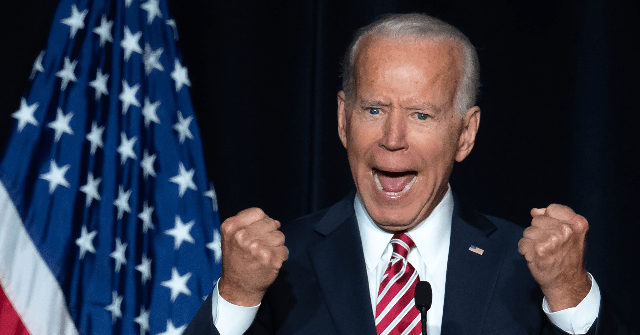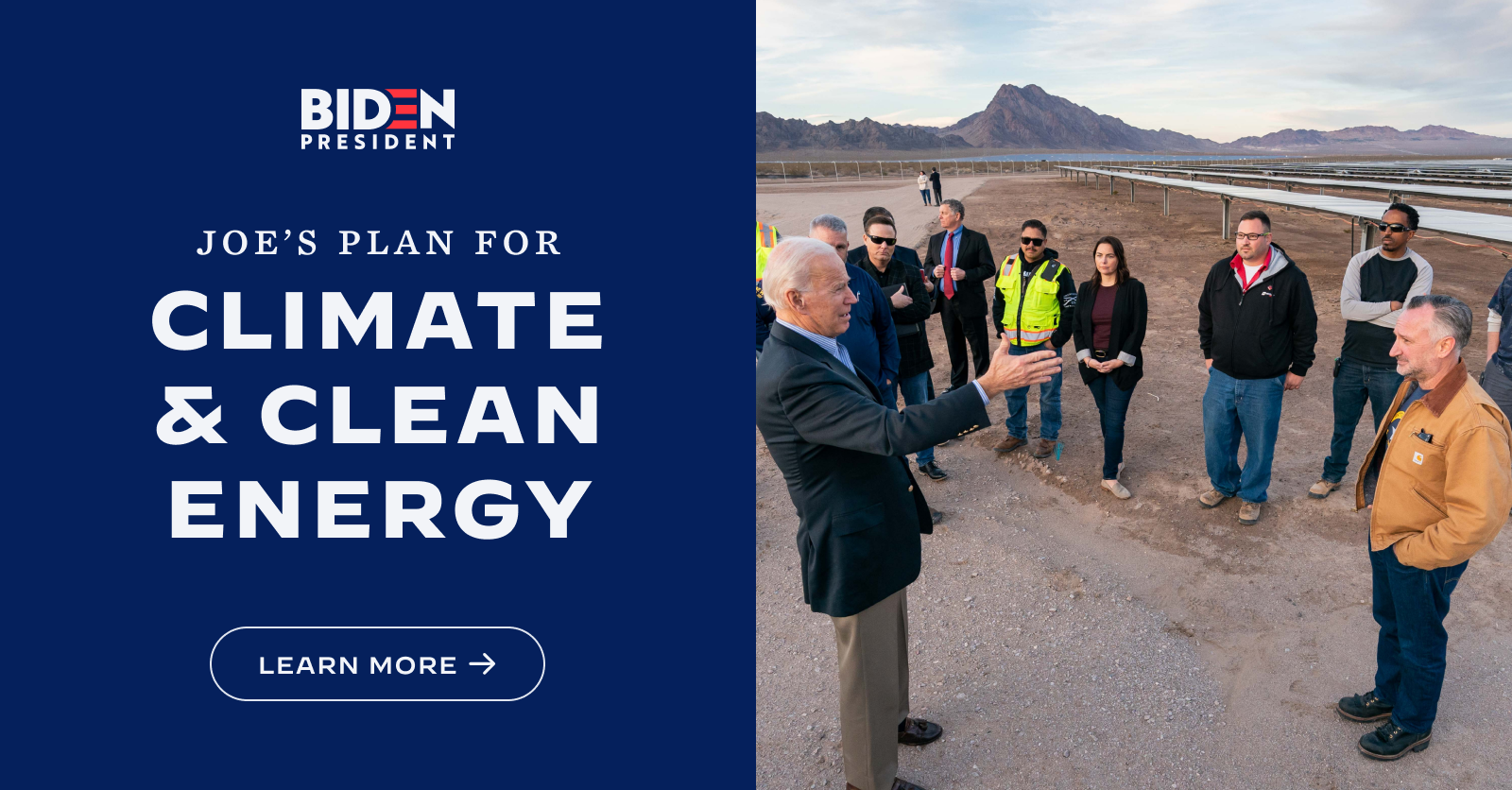
Even Without Senate, Biden Can Still Do Much To Fight Climate Change
Joseph A. Davis / Society of Environmental Journalists
(November 11, 2020) — If Republicans manage to keep the Senate, does that mean climate action in a Biden administration will be dead on arrival? Actually, far from it.
Yes, the grandest plans for reducing U.S. greenhouse gas emissions did assume control of Congress by Democrats. The odds of that now seem increasingly remote (check back after Georgia’s Senate runoffs in January).
But there are a lot of powerful climate actions a Biden administration could take — by executive action alone.
That, in fact, is what the Obama administration did, quite effectively, when the Senate refused to take up the Waxman-Markey climate bill that the House had passed in 2009. That experience illustrates a lot to learn about what works — and what doesn’t.
Obama turned to executive action, and accomplished a lot. Writing in InsideClimate News, Marianne Lavelle (who had chronicled the 2009 impasse) quotes old climate hands saying that executive action lacks durability. So true.
But it took Trump most of four years to roll back the Obama climate legacy. A Biden administration could roll much of it back out again … and could do it with the wisdom of hindsight.
Lavelle makes the point, too, that Biden’s 40+ years in the Senate leave him with some experience and talent in reaching across the aisle to work with Republicans. But a Republican Senate would certainly be led by Mitch McConnell, the senator from coal … er, Kentucky … who has relished the role of “Grim Reaper” as he kills Democratic bills.
In any case, any legislative climate action in the next two years would attract some Republican legislators, including those from fossil-fuel states. That could happen. Remember the carbon tax?
Let’s look at some of the possibilities, first the relatively easy, then the more obscure and geeky.

Reversing the Climate Reversal
➢ Paris Climate Accord: The pact is at the top of every list for a Biden administration. Under outgoing President Trump, the United States became the only nation in the world to drop out of it. The geniuses who wrote it (looking at you, Todd Stern) made it so Senate approval was not needed.
Biden could rejoin on his first day in office with the stroke of a pen. Yes, it would be largely symbolic, but symbolism is important. The act could start restoring the United States to a global leadership role on climate.
Of course, just being in the Paris pact isn’t enough. What is needed is getting nations to raise their ambitions, document their climate actions and pay for getting things done. That takes leadership and diplomacy.
Then there is the long list of Trump rollbacks to roll back. Many of these are regulatory actions, formal rulemakings under the procedural constraints of the Administrative Procedure Act, which means rolling them out again would take time. And face court challenges. But politically, some would be easy.
➢ Methane Rules: Methane is a powerful and overlooked greenhouse gas. For now, set aside the cow burps. A major share of U.S. methane emissions comes from the oil and gas industry (methane is essentially natural gas). A major part of the oil and gas industry is not opposed (may require subscription) to controlling emissions of methane, which after all can be a profitable commodity.
Today, new imaging technology shows us that many emissions are simply leaks from wells, pipes, etc. Obama issued two methane rules: one (by the Interior Department) for oil and gas facilities on federal lands (may require subscription), and one (by the U.S. Environmental Protection Agency) for other facilities. Trump repealed both. Biden could reissue them.
➢ Auto Emission Rule: Trump’s rollback of the Obama rule cutting down greenhouse gas emissions from cars and trucks has been an epic battle, one that has divided the industry and divided the states. Because going back toward the Obama rule might ease some political conflict, it seems feasible. People still love muscle trucks. But the market may be evolving toward more demand for electric cars — if we are to go by the instant sell-out of electric Hummers.
➢ Electric Power Plants: Trump’s EPA replaced Obama’s Clean Power Plan with its own industry-friendly Affordable Clean Energy plan. Originally, the controversy was over carbon dioxide emitted by coal-burning power plants. But as the energy market evolves away from coal, those plants keep closing anyway — largely because natural gas is cheaper. And renewables like solar and wind, which emit no CO2, are becoming cheaper still as technology improves.
A rollback of the rollback might be in order. But even more effective might be a new Biden emphasis on beefing up the power transmission grid and improving the cost-effectiveness of energy storage (batteries and more), which present major constraints to renewable electric power.
➢ NEPA Rule: The 1970 National Environmental Policy Act requires federal agencies to assess how major actions they take are going to affect the environment. This bedrock law is implemented by regulations. Trump weakened (may require subscription) the NEPA rule in 2020, eliminating the existing requirement for agencies to consider the cumulative impact of their actions on climate change. An incoming Biden administration could reverse this Trump action in several ways, including a new rulemaking.
➢ Other Rollbacks: The above are just some of the big executive-action possibilities that many people know about. The Trump administration performed a lot of other rollbacks that got less attention. Although not all pertain to climate, one good list is maintained by The New York Times (may require subscription) climate team, and another has been compiled by The Washington Post.
For instance, Biden could return to the Obama stance of allowing little or no leasing of coal, oil and gas on federal lands. He could use executive orders to promote federal purchase of electric cars. He could administer existing farm aid programs in ways that promote carbon storage in soil and forests. He could restore, or improve, federal energy-efficiency standards that Trump attacked. He could try to use his leadership to re-ignite bipartisan legislation to curb hydrofluorocarbons (family of powerful greenhouse gases) that almost got through the Senate in 2020 but hit procedural snafus.

Independent Agency Appointees Also Steer Environment Policy
Federal policies and actions that affect climate happen at many agencies beyond just EPA and the Department of the Interior. For instance, the government periodically must buy things in order to do its work — such as postal delivery trucks. The government administers billions of dollars in subsidies and incentives which can help or hurt climate.
Also, importantly, there are some regulatory agencies that are supposed to be “independent” that a president strongly influences via the person he appoints to run them. For example:
➢ FERC: The Federal Energy Regulatory Commission regulates, among other things, interstate transmission of energy via pipelines and high-voltage transmission wires. In the process, it regulates energy markets in an effort to keep them fair and legal. Its five commissioners are nominated by the president and confirmed by the Senate.
The Trump White House demonstrated the climate-relevance of FERC as recently as Nov. 5, when it demoted FERC Chairman Neil Chatterjee (a long-proven friend of fossil fuels) for not being fossil-friendly enough. He had recently acted in support of giving rooftop solar access to the grid and encouraging carbon pricing. When FERC approves a pipeline, it encourages the use of oil and gas.
FERC also licenses hydroelectric dams. It provides carbon-free energy, although environmentalists often dislike it for obstructing fish migration. Recent technological advances (like fish ladders) promise solutions. FERC can make these improvements a condition of its licenses. FERC also licenses pumped storage, which uses power to pump water uphill into a reservoir and then releases it through turbines to turn it back into power. While not always useful or appropriate, such energy storage can enhance the utility of renewables like solar and wind.
➢ SEC: The Securities and Exchange Commission, which regulates the stock markets and whose five commissioners are appointed by the president and confirmed by the Senate, has as its key mission to ensure markets are not fraudulent. But pay attention here — recently, a new issue under its gaze is the public disclosure of the risks posed by climate to the balance sheets of publicly traded corporations. The SEC could do more, administratively, to require such disclosure, which would in turn pressure corporations to take climate-friendly actions. Biden has supported stronger climate risk disclosure.
Climate Legislation a (Fuzzy) Possibility
Of course Democrats might end up with control of the Senate. But if it happens, it might be clearer what it means if we really knew what the Democrats wanted to do on climate.
Being Democrats, they have a lot of different ideas, put forth by a lot of different committees. Reconciling the Green New Deal Democrats, like Sen. Ed Markey (D-Mass.), with the fracking Democrats of Pennsylvania and the Pelosi centrists would take finesse.
In the end, however, a Biden administration could do much more if Democrats controlled both House and Senate. For example, that would allow enactment of major climate legislation.
And since Congress controls the power of the purse through appropriations, it would also allow bigger chunks of federal money to be spent on climate projects (such as funding solar and wind jobs).
Everything takes money. Or almost everything. The biggest immediate hope for big bucks coming out of Congress would be the next post-COVID-19 stimulus bill — if such a thing is even possible.
There is at least some finite possibility that it could happen in the lame duck session. Senate Majority Leader McConnell has indicated he wants one (may require subscription), although the really hard part is agreeing on terms.
Previous COVID-19 bills have offered bailouts to the oil and gas industry, without setting aside much for clean energy jobs. Any incoming Biden administration, even lacking a Senate majority, could try to use its clout to negotiate a more climate-friendly relief package. Insulating more houses, or buying electric school buses, would be great for climate, but it would need federal money.

Bipartisan Infrastructure Measures?
More is possible. Infrastructure spending (environmental pork to some) has gotten through Congress on a bipartisan basis, even in the most partisan of times.
Not only are there at least two appropriations bills (via Energy and Water, and Interior-Environment committees), but there are also large and almost inevitable authorizing bills like the water projects bill (the Water Resources Development Act) and a highway bill. Both are overdue.
In recent years, Democrats have succeeded in including many climate-friendly provisions and bacon-bits in them. Now that the election is over, their immediate legislative prospects are cloudy.
But we might also note that mammoth legislative packages often take more than one year — or more than one Congress — to pass. And we might also ask (annoyingly): Where is this mammoth, epochal climate legislation that people say may be impossible with a Republican Senate?
Fact is: it hasn’t really been drafted yet, much less introduced. What we have instead is outlines, concepts, slogans, talking points and aspirational statements. Not bill language. Hammering that out in multiple committees would take time.
It’s a project that a Biden administration and House Democrats could occupy themselves with while waiting for the next big election.
[Editor’s Note: See the latest headlines on possible executive actions from EJToday, as well as the recent SEJournal TipSheet, “Could Dems Borrow GOP Playbook To Roll Back Trump Rules?”].
Joseph A. Davis is a freelance writer/editor in Washington, D.C. who has been writing about the environment since 1976. He writes SEJournal Online’s TipSheet, Reporter’s Toolbox and Issue Backgrounder, as well as compiling SEJ’s weekday news headlines service, EJToday. Davis also directs SEJ’s Freedom of Information Project and writes the WatchDog opinion column and WatchDog Alert.
From the weekly news magazine SEJournal Online, Vol. 5, No. 41. Content from each new issue of SEJournal Online is available to the public via the SEJournal Online main page. Subscribe to the e-newsletter here. And see past issues of the SEJournalarchived here.
Posted in accordance with Title 17, Section 107, US Code, for noncommercial, educational purposes.